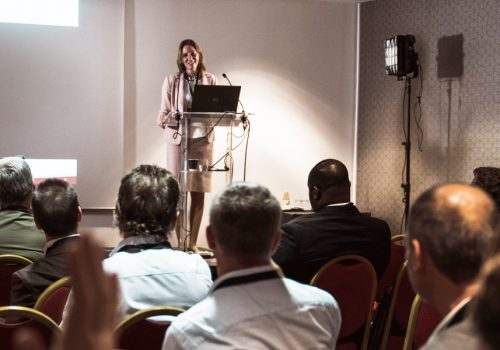We’re living and working in an amazing time. Continual improvements in technology are nothing short of mind-blowing. But we’re also living and working in a time that is mind-disturbing, because we are more connected but less engaged than ever before.
Indeed, numerous studies over the last couple of decades keep on sounding the same bell… That two-thirds or more of our workforce is disengaged. In other words, much of our workforce has lost their passion or their pursuit of excellence, and is content to do just enough to get by.
In a word, this lack of full, willing, and enthusiastic engagement is unsustainable, for two reasons:
First, you can’t afford it. When you pay someone $30 an hour, for example, and that person only delivers $10 worth of effort and results, your overhead goes up and your profits go down. Not good! Second, disengaged employees are contagious. Their negativity spreads to others and can easily destroy the morale in your organization.
Fortunately, there are 7 communication keys you can use right now to get and keep your people more engaged. Some of them might seem like common sense, but let me tell you as a speaker and consultant to more than 2000 organizations over the years, that these 7 communication keys are not common practice.
1. Make people feel welcome
When a colleague enters the building or jumps on a conference call, his first need is to feel welcome, that his presence and his input are welcome. And he needs to hear it in your words and in your tone of voice. It’s never good enough to cop out and tell yourself. “I don’t have to say anything because he already knows he’s welcome.”
Try the 4-minute rule. Instead of spending the first few minutes of your work day checking your email or responding to voice mail, spend the first 4 minutes of your day connecting with your people. Countless managers have told me it has made a dramatic and positive difference in their workplace.
2. Make time for conversation
Nobody wants to feel like a function… or a body that shows up for a job, puts in some hours, heads home, and then repeats the cycle for the next 40 years. No! Your people need to feel like they’re people, which only happens when you communicate with them. That’s why business leader Richard A. Moran says:
Treating people like numbers will prevent the company from meeting its numbers.
Again, don’t cop out. Don’t ever tell yourself: “I’m not a people person… I’ve got work to do” or “I don’t have time for all that communication stuff.” You either make time for conversation or live with a disengaged workforce. It’s that simple. Start with some occasional small talk. Over time ask braver questions. Then listen intently to what is being said and pausing before you add anything else.

3. Make people feel comfortable
Whether you know it or not, you’re either drawing people towards you or pushing them away. Do you know which one you are doing? Do you make people feel comfortable or uncomfortable? A highly engaged workplace is one where the people feel at ease instead of on edge. So, ask yourself:
Do you come across as a person of patience and encouragement, or are you known for having a short fuse?
Do people feel safe to say what they really think and feel at your meetings? Or do they say one thing at a staff meeting and something else in the hallway after the meeting? Does your office appear as though everything is in order and under control? Or does your prospective customer feel nervous, thinking she’ll probably be lost in the shuffle of your messy organization?
If you don’t know if you’re making people feel comfortable or uncomfortable, start asking around. Believe me, your people know the answer. And if you don’t like what you hear, do at least one thing every day that will make your workplace a safer, friendlier, and more engaging place to work.
4. Avoid communication killers
In a sense, this is the opposite of points 2 and 3, but it needs to be stated in the reverse. Avoid conversational turnoffs. The whole purpose of communication is to engage the other person. So, refrain from such behaviors as interrupting the other person when she is speaking, over-explaining an answer to the point of boring your listener to death, offering unsolicited advice, being evasive when answering a question, or being closed-minded and overly-opinionated.
Those behaviors disengage the people around you. Avoid arrogance. If you use big-sounding, pretentious words that make you feel smarter and the other person feel dumber, you’re bound to create some emotion, but it won’t be engagement. The same goes for bragging and one-upmanship. Don’t do it!
5. Make people feel important
The leaders who do the best job in engaging others use the inspiring power of importance. They tell their people that they’re important and their work is important. And they tell them over and over again.
Fred Smith, the founder of Federal Express, put it this way: “You have to communicate with your workers and make sure they understand that what they’re doing means something. We still tell our employees what we always told them: ‘You’re delivering the most important commerce in the history of the world. You’re not delivering sand and gravel. You’re delivering someone’s pacemaker, chemotherapy treatment for cancer drugs, the part that keeps the F-18s flying, or the legal brief that decides the case.” To make people feel important, use the Language of Validation. Tell people such things as:
“I respect… I admire… I celebrate… I value… or …I am thankful for.” And then finish the sentence with a specific behavior you’ve observed in the other person.
6. Make people feel appreciated
Yes, engaged people feel welcome, comfortable, understood and important, but the most engaged people also feel appreciated. In fact, it’s so critical that Dr. William James, the father of American psychology said, “The deepest craving in human nature is the craving to feel appreciated.”
Are you out there making your employees and customers feel appreciated? I hope so. You’ll never be able to give your employees all the money they want and you’ll never be able to give your customers all the discounts they want. But you can extend appreciation over and over again. It costs you nothing but gains you everything.
So tell your employees how much you appreciate their hard work, going the extra mile, being flexible in times of change, or just bringing a smile to the job site. Tell your coworkers how much you appreciate their positive attitude, how much you value their support, and how much you enjoy working with them. It will bring out the full and willing cooperation of the people around you.

7. Ask for what you need
If you want and need more engagement, ask for it. People don’t want to be told to “buckle up, to get with it, to show more enthusiasm, and to get more engaged”. And people don’t want their engagement to be taken for granted; they want to be asked.
So, be direct. Don’t hint. Don’t say, “It would sure be nice if we could start on time.” That’s not asking. That’s begging. A direct request would be: “Can I count on you being here at 8:00 a.m. sharp for our meeting on Tuesday?”
Second, be specific. The more specific you are about the behavior you want, the more likely you are to get it. Instead of saying: “We need to show a little more enthusiasm around here,” ask: “Will you please respond to your customer’s request by saying, ‘It would be my pleasure to help you?” Third, be positive. In other words, expect the other person to say yes to your request. As strange as it sounds, people sense your state of mind.
If you ask for more engagement, thinking “they’re going to say no”, they probably will say no. But if you approach someone with the expectation of a positive response, you will get a lot more yes responses.









